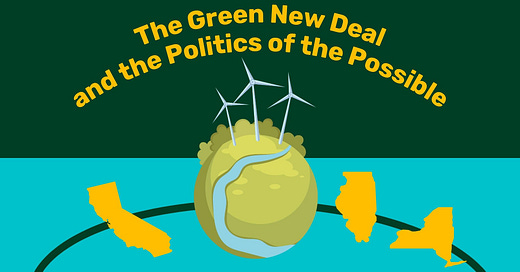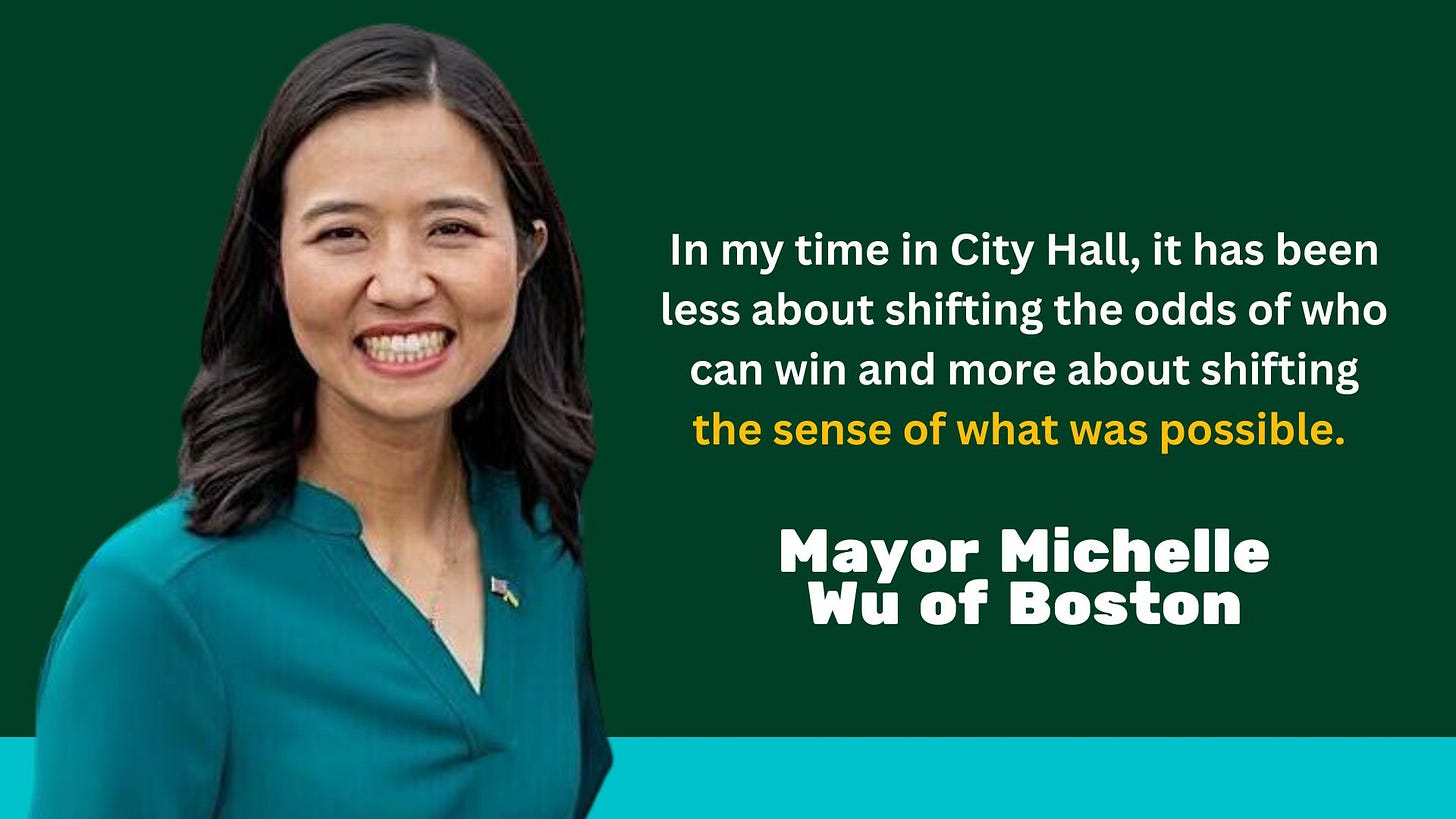The Green New Deal and the Politics of the Possible
By Jeremy Brecher, Senior Strategic Advisor, LNS Co-Founder
Listen to the audio version >>
The previous Commentaries in this series have examined many aspects of the Green New Deal that is emerging from below. This Commentary tells how the Green New Deal at the local state, and regional levels is transforming the limits of what people believe to be possible. The next several Commentaries will provide an overview of the programs, organizations, and politics that have made this transformation possible.
The Green New Deal is happening, and whatever happens is possible. The Green New Deal is not an impossible leftist fantasy, or something that could never win popular support, or a dream that couldn’t possibly be realized in practice, or something that would bring disaster if it were realized. The Green New Deal is being created right now by flesh-and-blood people under real-life conditions. It is being created in communities, cities, states, and regions — from below.
Of course, only a limited proportion of US geographies and institutions have fully developed Green New Deals. But efforts to create Green New Deals are ubiquitous; an article in Popular Science magazine soon after the first Green New Deal proposal in Congress found that plans and first steps to realize Green New Deals were happening in every state in the union.[1] Today the Green New Deal from Below, dispersed throughout the US, is transforming the realities where it is – and creating models for broader transformation everywhere.
Green New Deals in cities like Boston and Los Angeles are reducing the greenhouse gases that are destroying our climate. They are creating jobs protecting the climate and training workers to fill them. They are mobilizing city resources to reduce poverty. They are investing in climate-protecting buildings and technologies in low-income neighborhoods. They are expanding cheap or free public transit to reconnect isolated neighborhoods, provide people who lack cars with access to jobs, and reduce greenhouse gas pollution.
In states like Illinois, California, and New York, Green New Deal-style programs are shifting major resources to climate-safe energy development. They are setting targets for greenhouse gas reduction and schedules for shutting down fossil fuel producing and using facilities – and implementing them. They are reducing fossil fuel use by increasing the energy efficiency of buildings, transportation, agriculture, and other energy users. They are investing in infrastructure to correct historical injustices like the concentration of polluting facilities in poor communities. They are creating jobs in the green economy with high labor rights and standards and providing job training, job ladders, and jobs for people who have been marginalized in the labor market.
Unions like the Electrical Workers are promoting programs to expand renewable energy production; building coalitions to support them; training the workers needed to realize them; and monitoring the results to ensure that they produce good union jobs. Unions of educators and nurses are fighting for – and winning – green schools and hospitals.
The Green New Deal from Below is showing that it is possible to challenge the powers that are imposing climate change, inequality, and oppression. That it is possible to formulate realistic alternatives. And that those alternatives can actually be implemented.
It is possible to look at the diverse projects, programs, and initiatives of the Green New Deal from Below and see them as simply scattered, unconnected, one-off phenomena. But that would be like saying, I see the students, the classrooms, and the football field, but where is the University? The Green New Deal from Below is indeed composed of many parts, but that does not prevent it from being a real entity as a whole. This and the following Commentaries identify some of the commonalities and connections that make it a whole.
Shifting the Sense of What Is Possible
The Green New Deal transformed America’s political imagination. It transgressed the neoliberal, market-only assumptions that dominated public discourse for four decades. It proposed the long-disparaged notion of using government to solve problems. It refused to accept the growing inequality that had reshaped American society. It advocated tackling rather than ignoring the climate emergency. To paraphrase Green New Deal Mayor Michelle Wu of Boston, it shifted “the sense of what was possible.” It thereby expanded the limits of what was possible.
This transformation flows from the core concepts of the Green New Deal. These core concepts integrate multiple concerns rather than addressing them in separate “silos” or adding them together in “laundry lists.” They unite the urgent and universal need for climate protection with the economic and social needs of disadvantaged groups and of working people as a whole. They do so by articulating a strategy for rapid greenhouse gas reduction that prioritizes programs that create jobs and reduce injustice. This strategy provides a new way of integrating the interests of previously disconnected or antagonistic constituencies.
The Green New Deal is not just a slogan, a list of demands, or a menu of policies. The Green New Deal provides a framework for moving beyond piecemeal policies to a set of integrated strategies. Like the original New Deal, it makes seemingly antagonistic policies and constituencies complementary by transcending the limitations of established assumptions. It proposes a set of changes in the social framework that meet both the common and the distinct needs of those affected. It thereby constructs a common interest that incorporates the particular interests of different groups. This allows needs and interests that may currently appear incompatible – for example, between jobs and environment – to become compatible or even synergistic.[2]
The Green New Deal that is emerging in cities, states, and civil society integrates such distinct elements in two ways.
First, it integrates different kinds of needs and their solutions. Front and center is its integration of the need for climate protection, the need for good jobs, and the need for greater equality. But it integrates other needs as well. For example, it combines policies that attack entrenched forms of discrimination and injustice with ones that increase the power of workers on the job by strengthening their right to organize and engage in concerted action. Legislation in Connecticut and other states exemplifies this by requiring that offshore wind clean energy projects provide both Project Labor Agreements ensuring union wage standards and conditions and Community Benefit Agreements providing job access for communities and demographics deprived of access to good jobs.
Second, these Green New Deals from below integrate the needs of different constituencies. For example, two separate coalitions backing different bills developed in Illinois to shape climate legislation. One, the Illinois Clean Jobs coalition, was rooted in the environmental movement and local social justice organizations. The other, the Climate Jobs Illinois coalition, was based in the state’s labor unions. After considerable tension and extended negotiations, the two united on a common program that included the demands of each – laying the basis for the Climate and Equitable Jobs Act[3], described by one journalist as a “Green New Deal” for Illinois.
Integrating programs and integrating people go hand in hand. For example, the Green New Deal from Below tames the purported conflict between employment and climate protection. It challenges the “jobs vs. environment” frame. At a local and state level, the Green New Deal from Below has therefore been able to unite often-divided labor, environmental, and climate justice advocates.
The next several Commentaries in this series will examine the strategies that the Green New Deal from Below had used to integrate diverse, apparently conflicting social needs with diverse, even opposed constituencies.
[1] April Reese, “What a Green New Deal Would Look Like in Every State,” Popular Science, February 27, 2020. https://www.popsci.com/story/environment/green-new-deal-state-by-state/
[2] This interpretation draws on the concept of the “historic bloc” outlined by the Italian thinker Antonio Gramsci. Gramsci’s historic bloc establishes “a synthesis of the aspirations and identities of different groups in a global project which exceeds them all.” Such a synthesis becomes possible, notwithstanding current antagonisms, if the parameters of what is considered possible are expanded. Perry Anderson, “Problems of Socialist Strategy,” in Perry Anderson and Robin Blackburn, eds., Toward Socialism (Ithaca: Cornell UP, 1965) p. 243. https://www.worldcat.org/title/towards-socialism/oclc/266133
For a more recent explication of Gramsci’s concept of “historical bloc” and a review of recent interpretations see Panagiotis Sotiris, “Gramsci and the Challenges for the Left: The Historical Bloc as a Strategic Concept,” Science and Society, Vol. 82, No. 1, December 2017. https://guilfordjournals.com/doi/10.1521/siso.2018.82.1.94






